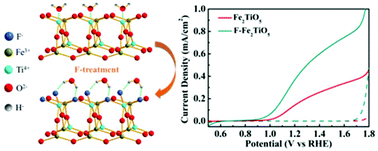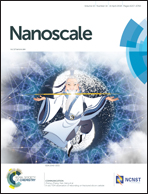Enhanced solar water-splitting activity of novel nanostructured Fe2TiO5 photoanode by electrospray and surface F-modification†
Abstract
Fe2TiO5 is recognized as a novel photoanode material for solar water splitting. However, it has been seldom studied as a photoelectrode by itself, and its practical performance still needs to be improved. Herein, nanostructured Fe2TiO5 photoanode is prepared by the electrospray technique. The effects of the synthesis parameters on the photoelectrochemical water splitting activity are studied including the substrate temperature and film thickness. In addition, surface F-modification is applied on pure Fe2TiO5 to further improve its photoelectrochemical performance. Also, the water splitting photocurrent of F-treated Fe2TiO5 increases to 0.4 mA cm−2 at 1.23 VRHE, which is higher than that of pristine Fe2TiO5. X-ray photoelectron spectroscopy confirms the formation of surface Ti–F bonds after surface F-treatment, which facilitates the transfer of holes and the breakage of O–H bond under illumination. The enhanced performance can be attributed to a synergetic effect of nanoarchitecture and surface F-modification. Therefore, the nanoarchitecture assisted by surface F-modification offers an effective strategy to prepare high-efficiency nanostructured complex metal oxides for solar water splitting.



 Please wait while we load your content...
Please wait while we load your content...